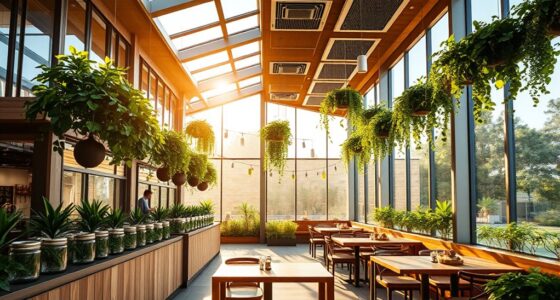Culinary tourism partnerships involve working with local chefs, artisans, farmers, tourism boards, and event organizers to create authentic food experiences that attract visitors and boost local economies. By building strong relationships, aligning goals, and collaborating on marketing efforts, you can showcase regional flavors through food tours, festivals, and exclusive events. These partnerships help preserve traditions, foster community pride, and elevate your destination’s appeal. To learn how to develop and sustain successful culinary collaborations, keep exploring these effective strategies.
Key Takeaways
- Identify and engage local stakeholders such as chefs, farmers, and artisans to build collaborative culinary networks.
- Develop strategic marketing partnerships with tourism boards and media to promote regional food experiences.
- Organize and promote food festivals, tasting tours, and culinary events to attract visitors and media attention.
- Establish culinary ambassador programs to enhance storytelling, branding, and community engagement.
- Create immersive food experiences and behind-the-scenes tours to deepen visitor connections and showcase local flavors.
The Rise of Culinary Tourism and Its Impact on Destinations
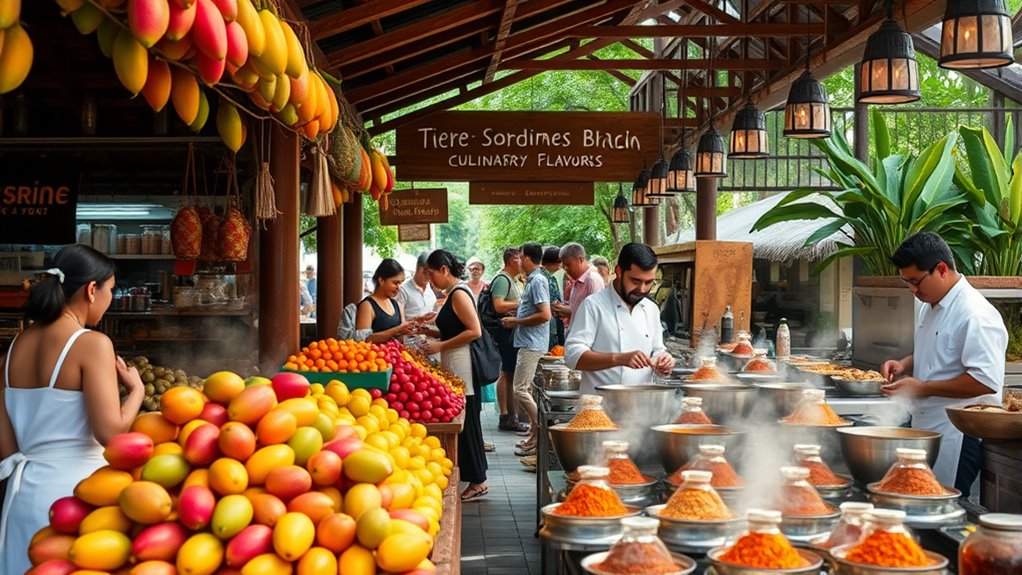
Culinary tourism has experienced a significant rise in recent years, transforming how destinations attract visitors. You’ll notice that food experiences now play a central role in travel decisions, often shaping travelers’ perceptions of a place. This trend encourages destinations to showcase their local flavors, traditional dishes, and unique culinary traditions to stand out. As a result, tourism becomes more immersive, allowing visitors to connect deeply with a region’s culture. With social media amplifying food experiences, destinations see increased exposure and foot traffic. This shift boosts local economies, supports small businesses, and promotes cultural preservation. Additionally, integrating branding and marketing strategies helps destinations craft compelling narratives around their culinary offerings, further strengthening visitor engagement. Ultimately, culinary tourism has become a powerful tool for destinations seeking to differentiate themselves and create memorable, authentic experiences for travelers.
Building Strategic Partnerships With Local Food Stakeholders
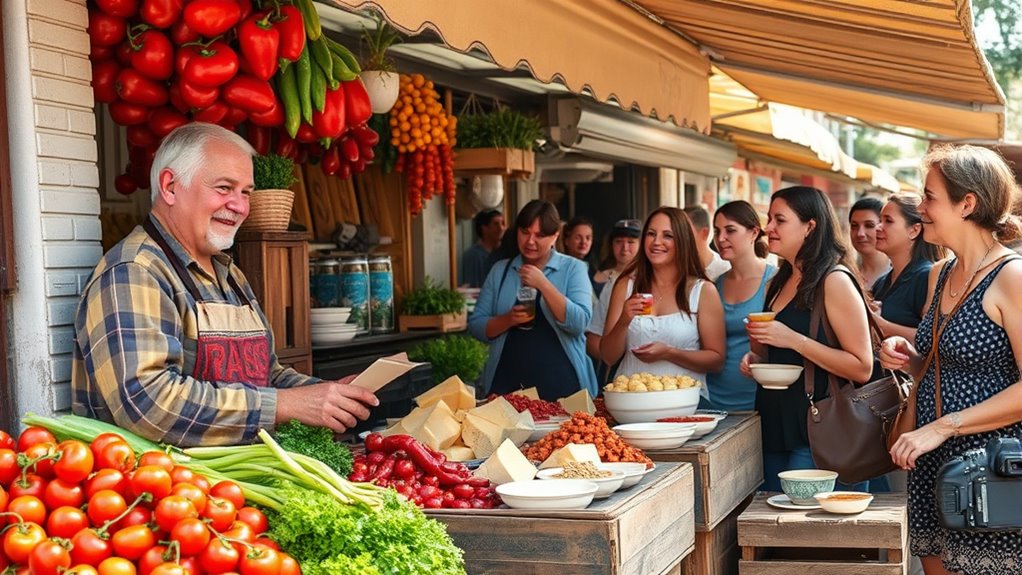
To build strong culinary tourism partnerships, you need to identify who the key local food stakeholders are and understand their roles. You should focus on cultivating collaborative relationships that benefit everyone involved. Make sure your goals and visions align to create a unified approach that drives success. Incorporating effective communication strategies ensures all parties stay engaged and motivated throughout the partnership process.
Identifying Key Stakeholders
How can you effectively identify the key stakeholders essential for building strategic partnerships in culinary tourism? Start by mapping out all local food-related entities, including chefs, restaurant owners, farmers, food producers, and market organizers. Attend community events, farmers’ markets, and industry gatherings to meet potential partners and observe their roles firsthand. Conduct interviews or surveys to understand their needs, goals, and willingness to collaborate. Leverage existing networks, social media, and local chambers of commerce to discover influential players. Focus on those who share a common vision for promoting regional cuisine and can contribute resources or expertise. By carefully analyzing these connections, you’ll pinpoint stakeholders whose involvement will strengthen your culinary tourism initiatives and foster sustainable, mutually beneficial partnerships. Additionally, understanding building regulations and zoning laws can help ensure that collaborations adhere to legal requirements and facilitate smoother project implementation.
Cultivating Collaborative Relationships
Building strong, collaborative relationships with local food stakeholders requires intentional effort and ongoing engagement. You need to communicate openly, listen actively, and demonstrate genuine interest in their perspectives. Attend community events, visit farms, and support local producers to build trust and rapport. Establish clear channels for dialogue that encourage feedback and shared ideas. Recognize each stakeholder’s strengths and contributions, and find common ground to foster mutual benefits. Consistency is key—maintain regular contact to nurture the relationship over time. By demonstrating commitment and respect, you create a foundation for collaboration that benefits everyone involved. Strong partnerships grow from trust, transparency, and shared goals, ultimately enhancing your culinary tourism efforts and strengthening the local food community. Utilizing digital platforms can further facilitate communication and coordination among stakeholders.
Aligning Goals and Visions
Aligning goals and visions with local food stakeholders is essential for creating effective and lasting partnerships. When everyone’s on the same page, collaboration becomes smoother, and your initiatives gain momentum. To do this successfully, consider these steps:
- Identify shared values—find common ground that motivates all parties.
- Clarify objectives—set clear, measurable goals that benefit everyone.
- Communicate openly—maintain transparency to build trust and prevent misunderstandings.
- Align strategies—ensure actions and resources support the shared vision.
Collaborating With Chefs and Restaurants to Showcase Authentic Flavors
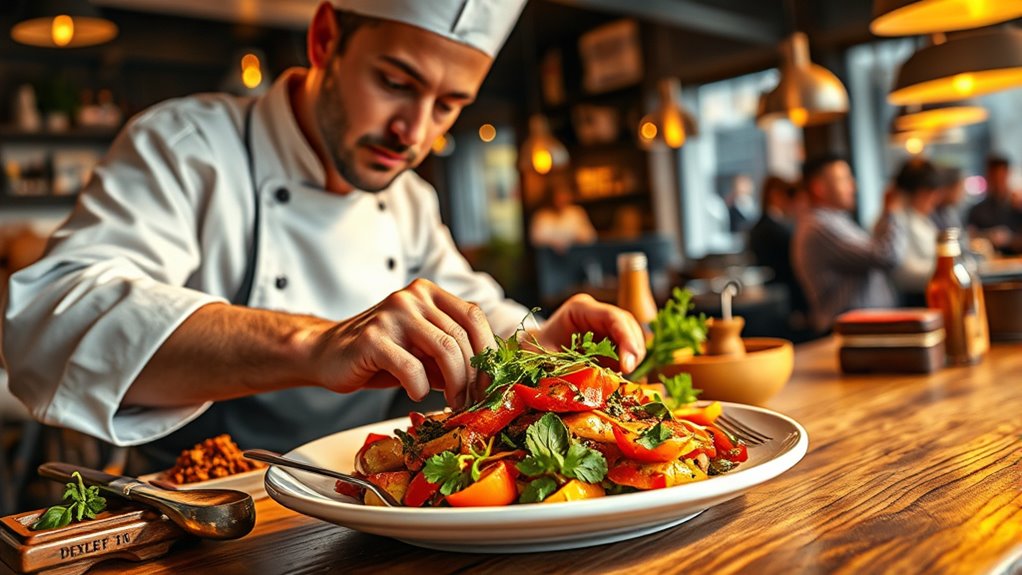
Collaborating with chefs and restaurants offers a powerful way to highlight authentic flavors and create memorable culinary experiences. By partnering with local culinary talents, you can showcase regional ingredients and cooking techniques that resonate with visitors. Encourage chefs to develop signature dishes or tasting menus that tell a story about the area’s food heritage. Hosting exclusive events, such as chef’s tables or cooking classes, invites tourists to engage directly with the culinary process. These collaborations not only elevate the destination’s reputation but also foster deeper connections between visitors and local culture. To succeed, guarantee open communication and align on the shared goal of authentic representation. Incorporating best anime movies into culinary-themed events can also add a fun and engaging element that attracts diverse audiences. By working closely with chefs and restaurants, you turn culinary exploration into a defining feature of your destination.
Integrating Food Producers and Artisans Into Tourism Experiences

Incorporating local food producers and artisans into tourism experiences offers visitors an authentic glimpse into a destination’s culinary landscape. You can achieve this by creating opportunities for visitors to meet artisans, taste handcrafted products, and learn about traditional techniques. Here are some effective ways to do this:
- Organize farm or workshop tours where tourists see production firsthand.
- Host hands-on classes with artisans, allowing visitors to craft or cook using local ingredients.
- Set up markets or pop-up shops featuring local producers’ products.
- Develop storytelling experiences that highlight artisans’ histories and craft processes.
- Understanding the best arcade machines for home game rooms can inspire creative themes and attractions for visitor engagement.
These interactions deepen visitors’ appreciation for local culture and support small producers. Integrating artisans into your tourism offerings creates memorable, authentic experiences that resonate long after the visit.
Leveraging Tourism Boards to Promote Culinary Destinations
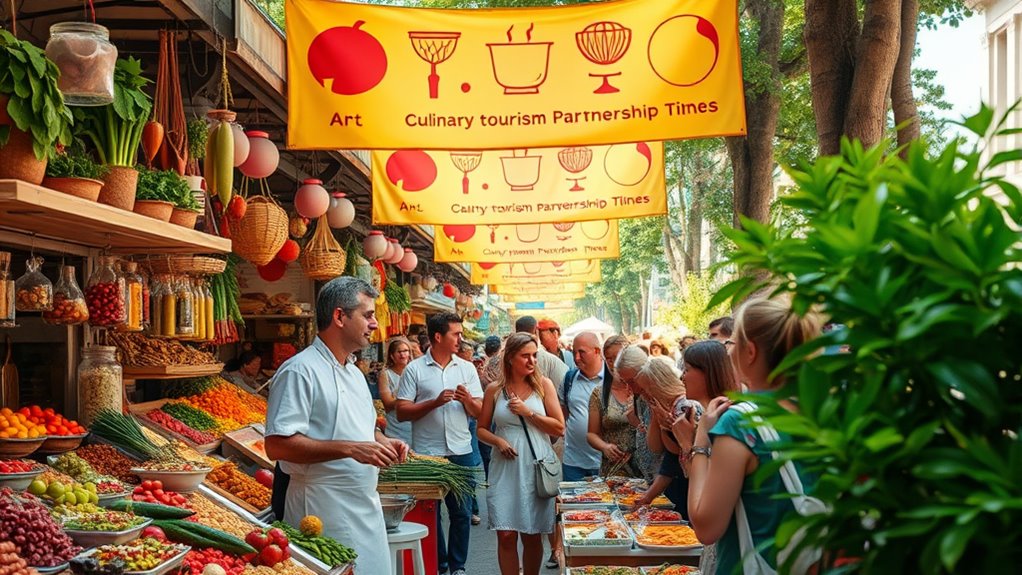
Tourism boards play a vital role in boosting culinary destinations through strategic marketing collaborations that reach wider audiences. They also promote destination events and festivals that highlight local flavors, attracting more visitors. Additionally, culinary ambassador programs help showcase chefs and food artisans, creating authentic connections that inspire travelers to explore the region. Incorporating destination-specific organization efforts can further enhance local engagement and sustainable tourism growth.
Strategic Marketing Collaborations
Leveraging tourism boards in strategic marketing efforts can substantially boost the visibility of culinary destinations. You can do this by forming partnerships that align your culinary offerings with broader tourism campaigns. Here are four ways to maximize these collaborations:
- Co-create marketing materials that highlight local food scenes, festivals, and chef-led experiences.
- Share data with tourism boards to target specific audiences interested in culinary travel.
- Participate in joint advertising campaigns, including digital and print media.
- Coordinate press trips that showcase your destination’s unique flavors to journalists and influencers.
- Incorporate innovative Unique and Wicked Planters into promotional displays to enhance the visual appeal of culinary venues and create memorable experiences for visitors.
Destination Event Promotion
Building on strategic marketing collaborations, promoting culinary destinations through targeted events can substantially increase visibility and attract visitors. Tourism boards play a crucial role by organizing food festivals, tasting tours, and cooking competitions that spotlight local flavors. These events draw media attention and generate buzz, encouraging travelers to experience the destination firsthand. To maximize impact, coordinate with local chefs, vendors, and media partners, creating a cohesive promotional strategy. Consider this approach:
| Event Type | Key Benefits | Target Audience |
|---|---|---|
| Food Festivals | Wide exposure, media coverage | Food lovers, tourists |
| Cooking Competitions | Community engagement, PR boost | Aspiring chefs, locals |
| Tasting Tours | Immersive experience | Culinary enthusiasts |
| Chef Demonstrations | Live engagement, branding | Tourists, media |
| Cultural Events | Authentic local experience | Cultural tourists |
These targeted events elevate your culinary destination’s profile, enticing visitors and fostering lasting impressions.
Culinary Ambassador Programs
Have you considered how passionate local residents and industry professionals can become powerful advocates for your culinary destination? Culinary ambassador programs empower these individuals to share their love for local food, creating authentic promotion. To build an effective program, you should:
- Select passionate locals and chefs as ambassadors.
- Provide training on key messaging and storytelling.
- Offer exclusive experiences or incentives for participation.
- Encourage ambassadors to share content on social media and at events.
- Incorporate training on effective communication techniques to enhance ambassadors’ engagement and outreach efforts.
Creating Immersive Food Tours and Experiences for Visitors

Creating immersive food tours and experiences transforms ordinary visits into memorable adventures that deeply engage you with a destination’s culinary culture. These experiences go beyond tasting; they involve storytelling, hands-on activities, and interactions with local chefs and artisans. By designing multi-sensory journeys, you connect emotionally and learn about regional ingredients, traditions, and history. To succeed, focus on authenticity, local partnerships, and tailored itineraries. For example:
| Key Element | Description | Benefit |
|---|---|---|
| Local Guides | Share authentic insights | Enhance credibility |
| Hands-on Activities | Cooking classes or harvests | Increase engagement |
| Themed Routes | Focus on local specialties | Deepen cultural understanding |
| Storytelling | Share origin stories | Build emotional connections |
| Exclusive Access | Behind-the-scenes visits | Create memorable moments |
This approach ensures visitors leave with a genuine appreciation of your destination’s culinary soul. Additionally, integrating creative practice into tour design can foster innovative ways to showcase local culture and cuisine.
Benefits of Culinary Partnerships for Local Communities and Businesses
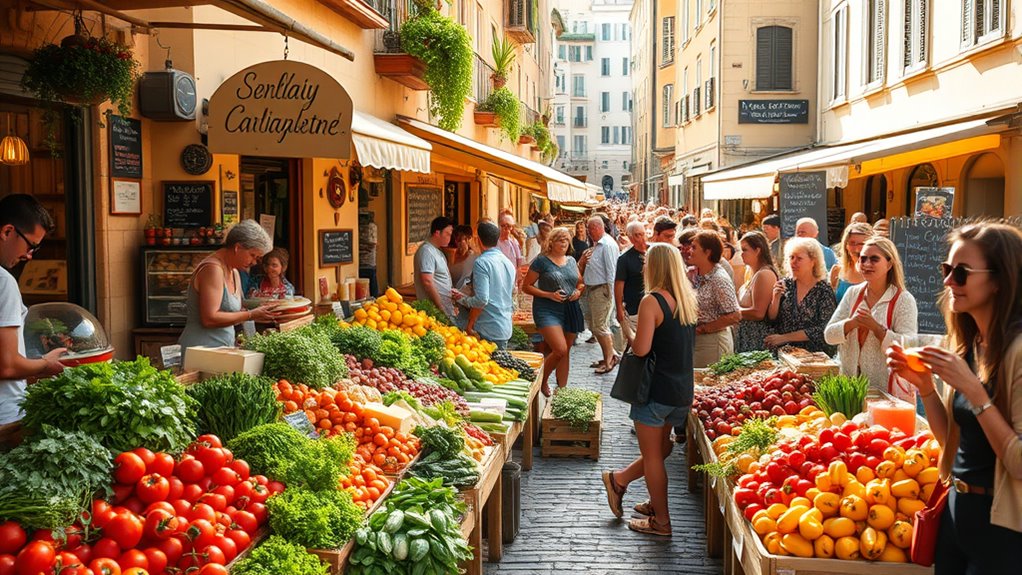
Culinary partnerships can considerably boost local communities and businesses by fostering economic growth and cultural pride. When you collaborate with local chefs, farms, and artisans, you create a vibrant food scene that attracts visitors. This leads to several benefits:
- Increased revenue for local businesses as visitors spend more on food and souvenirs.
- Job creation within the community, supporting local employment.
- Preservation of culinary traditions and cultural identity through shared knowledge.
- Enhanced reputation, making your area a sought-after destination for food lovers.
Case Studies of Successful Food Tourism Collaborations

One of the most compelling examples of successful food tourism collaboration is the partnership between Portland, Oregon’s local farmers’ markets and renowned chefs. This collaboration has created a vibrant farm-to-table movement that attracts visitors enthusiastic to experience fresh, local ingredients firsthand. Chefs source directly from farmers, showcasing seasonal produce in their menus and promoting local agriculture. The farmers benefit from increased sales and visibility, while visitors enjoy authentic culinary experiences. Events like chef-led tours, cooking classes, and markets tied to specific festivals deepen engagement and draw tourism. This partnership boosts local economy and fosters community pride. By aligning culinary expertise with sustainable farming, Portland exemplifies how strategic collaborations can elevate food tourism and benefit all stakeholders involved.
Future Trends in Culinary Tourism Partnerships

How will evolving technology and changing traveler preferences shape the future of culinary tourism partnerships? It’s clear that digital innovations and personalized experiences will play a bigger role. Here’s what you can expect:
Evolving tech and traveler preferences will make culinary tourism more personalized, immersive, and accessible through digital innovations and authentic experiences.
- Increased use of virtual reality to preview culinary experiences before booking.
- Greater emphasis on sustainability and locally sourced ingredients in collaborations.
- Enhanced mobile apps offering seamless, real-time booking and personalized recommendations.
- Partnerships that focus on immersive, authentic cultural food experiences driven by AI insights.
These trends will make culinary tourism more accessible, engaging, and tailored to individual tastes. By embracing technology and shifting preferences, you’ll find new opportunities to connect with local food scenes and create memorable, meaningful culinary journeys.
Frequently Asked Questions
How Do Culinary Partnerships Influence Local Cultural Preservation Efforts?
You might wonder how collaborations around food impact local culture. When you form culinary partnerships, you help preserve traditional recipes, cooking techniques, and regional ingredients. These efforts encourage community pride and sustain cultural identity. By promoting local cuisine to tourists, you support artisans, farmers, and chefs, ensuring cultural practices stay alive. Ultimately, your involvement in these partnerships helps protect and celebrate unique local heritage while boosting the economy.
What Funding Models Support Sustainable Food Tourism Collaborations?
You can explore various funding models to support sustainable food tourism collaborations. Grants from government agencies, cultural organizations, and tourism boards often provide initial support. Crowdfunding and private sponsorships also play a crucial role. Additionally, revenue-sharing models from local businesses and eco-tourism funds encourage ongoing collaboration. By combining these options, you guarantee long-term sustainability, promote local culture, and foster authentic culinary experiences that attract tourists and benefit the community.
How Can Small-Scale Food Producers Benefit From Tourism Partnerships?
You can benefit from tourism partnerships by showcasing your unique products to a broader audience. These collaborations attract more visitors, increasing your sales and visibility. You might also gain access to shared resources, marketing opportunities, and training that improve your skills. Plus, working with tourism partners helps build your reputation locally and beyond, opening doors for future growth. Embrace these partnerships to grow sustainably and turn visitors into loyal customers.
What Challenges Arise in Coordinating Diverse Culinary Stakeholders?
When coordinating diverse culinary stakeholders, you face challenges like aligning different goals, managing communication gaps, and balancing varied expectations. You need to foster collaboration among producers, chefs, and marketers who may have conflicting interests. Additionally, cultural differences and resource limitations can complicate efforts. To succeed, you must build trust, establish clear roles, and create a shared vision, ensuring everyone’s contributions work together toward common tourism and culinary goals.
How Do Digital Technologies Enhance Food Tourism Collaborations?
Digital technologies boost food tourism collaborations by making communication easier and faster. You can connect with local chefs, vendors, and tourists through social media, apps, and websites. These tools help you share vibrant food stories, promote events, and gather feedback efficiently. They also enable real-time updates and personalized experiences, strengthening relationships among stakeholders and attracting more visitors. Embracing digital tech makes your culinary collaborations more dynamic, accessible, and successful.
Conclusion
As you explore culinary tourism, you might find that the most memorable experiences often come from unexpected collaborations. When you partner with local chefs, artisans, and tourism boards, you create authentic, immersive flavors that leave visitors craving more. It’s a coincidence of passion and partnership that transforms a destination into a culinary haven. Embrace these connections, and you’ll discover how the perfect recipe for success is built on shared flavors and shared visions.



